There is nothing quite like being snug in your bed late at night and being woken up by something flying up your nose.
After your initial shriek, when you are actually awake, and you realize it is a fungus gnat you shriek again because this isn't your first rodeo when it comes to those nasty little varmints.
If you grow houseplants chances are you have had fungus gnats at least once and probably more than once, like me, if you have been growing them for a while.
What Are Fungus Gnats?
Fungus gnats are small flies that infest soil, potting mix, other container media, and other sources of organic decomposition. Their larvae primarily feed on fungi and organic matter in the soil, but also chew roots and can be a problem in greenhouses, nurseries, potted plants, and interior plantscapes.
How They Damage Plants
The adult gnats that you see flying around your house do not damage your plants and they do not bite people, although when they land on me they irritate my skin.
What you have to be concerned about are the larvae, which can cause significant root damage and even plant death. It takes 3 to 4 weeks for an adult gnat to form from the larvae. So, when you see those nasty gnats flying around you know that larvae are already down in your pots eating away at the roots.
What Causes Fungus Gnats
Fungus gnats thrive in moist conditions, so the best way to avoid them is to not overwater and to make sure that pots have good drainage. However, as much as I monitor my watering by checking the soil surface to make sure it is dry, I still occasionally get fungus gnats.
Also, make sure you are buying your potting soil from a reputable company as you can bring in a host of problems with new bags that you bring into your home.
How I Get Rid Of Fungus Gnats
First of all, I never use chemicals in my home, and chemicals are rarely needed to control them in noncommercial settings.
I use the same method each time I get them and it has always worked for me. I cover the soil of each houseplant pot in my house with clean sand, making sure that it covers the entire surface. The sand stops the gnats from leaving or entering the soil and disrupts their cycle. You can also use gnat nematodes
I then use sticky traps to catch the adults because I can't stand those little menaces.
Shop Products:
Gnat Traps Sticky Stakes Desert Sand Soil Cover
Gnat Nematodes Potting Mix Organic Potting Soil
When I look around my apartment at all of the little yellow sticky traps I feel like I have somehow failed as a houseplant mama, but I know that I am giving the best care to help them heal.










Okay Laura the word Fungus freaked me out. Put that with gnat one of the most annoying bugs besides flies and I'm not happy. These two bugs are truly annoying.
ReplyDeleteI'm not a sissy by any means. I kill all the bugs in my house. Gnats and flies drive me crazy. Good luck with getting rid of them
Been there, done that. I hate those pesky gnats. I can't imagine how hard they'd be to get rid of in a nursery.
ReplyDeleteBrenda
I do hate gnats.
ReplyDeleteGreat tip to use the sand! I did learn something - thanks!
ReplyDeleteThat's a great idea using sand! Also I didn't know such a thing existed, as those gnat sticky traps! I like the idea of using them outside in my potted plants to maybe catch the little critters that eat the plant leaves! I wish I could find something for my raspberries, as I'm sure it's some sort of larvae that get in them and then hatch out and eat and chew on my leaves and even the berries! I've tried many things and so far nothing works. thanks for the great ideas! Marilyn
ReplyDeleteI have never heard of these gnats. I am glad you know how to take care of this problem. Your plants are so beautiful and it would be a shame to lose any of them. I am sure you have given some great advice to people that have this same problem. Happy Wednesday. xoxo Kris
ReplyDeleteThose little things are a pain in the butt. I'm going to try your sand trick for our pot plants. Thank you
ReplyDelete